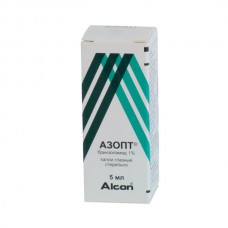Expiration date: 03/2026
The composition and form of issue:
Eye drops, 1 ml contains:
brinzolamide 10 mg
excipients: benzalkonium chloride solution (equivalent to benzalkonium chloride) disodium edetate sodium chloride tyloxapol mannitol, carbomer (974P) sodium hydroxide and/or acid hydrochloric concentrated (reduction of pH) purified water
in bottles plastic with dropper-dispenser "Drop Tainer™" 5 ml in a cardboard pack 1 bottle.
Description pharmaceutical form:
Homogeneous suspension of white or almost white.
Pharmacokinetics:
The local application brinzolamide penetrates into the bloodstream.
Brinzolamide in erythrocytes adsorbed by the selective linking. The formation of metabolite — N-desethyl brinzolamide, which also binds to carbonic anhydrase and accumulates in red blood cells. In the presence brinzolamide metabolite binds mainly to carbonic anhydrase I.
The plasma concentration brinzolamide and its metabolite below the limit of quantitation (<10 ng/ml). T1/2 is 111 days. The plasma protein binding is about 60%.
Brinzolamide write mainly with urine in an unmodified form. The main metabolite (N-desethyl brinzolamide) and low concentrations of other metabolites (N-desmetiana and desmethyl) is also found in the urine.
Description pharmacological action:
Brinzolamide is an inhibitor of carbonic anhydrase II. Due to inhibition of carbonic anhydrase II is a slowdown in the education of bicarbonate ions with subsequent reduction in transport of sodium and fluid, which leads to decrease the production of intraocular fluid in the ciliary body of the eye. The result is a reduction in intraocular pressure (IOP).
Indications:
Reduction of elevated IOP in diseases such as:
- open-angle glaucoma
- ocular hypertension.
Contraindications:
- individual hypersensitivity to product components
- patients with severe renal impairment (Cl creatinine <30 ml/min) — as Azopt™ and its metabolites are excreted by the kidney
- children's age, because at the moment the safety and efficacy of the drug for children has not been established.
With caution:
- patients with angle-closure glaucoma (the use of the drug has not been studied)
- patients with severe liver disease (the use of the drug has not been studied).
Sensitization of the organism sulfonamides can develop if the drug is administered repeatedly in accordance with the instructions for its use. At occurrence of serious adverse reactions or signs of hypersensitivity, the drug should be discontinued.
Application of pregnancy and breast-feeding:
Adequate and well-controlled studies in pregnant women did not. Perhaps the use of the drug for the treatment of pregnant women prescribed by a doctor, if the expected therapeutic effect exceeds the risk of potential side effects to the fetus.
You should stop breast feeding while using the drug.
Side effects:
In 5-10% of cases: blurred vision, bitter, sour or unusual taste in the mouth.
In 1-5% of cases: blepharitis, dermatitis, dry eye, foreign body sensation, headache, hyperemia of the conjunctiva, discharge from the eyes, discomfort in eyes, keratitis, pain and itchy eyes, rhinitis.
Less than 1% of the cases: local reactions — conjunctivitis, keratoconjunctivitis, double vision, keratopathy, lacrimation, asthenopia, crust on the eyelids systemic reactions — dizziness, hypertension, shortness of breath, chest pain, dry mouth, dyspepsia, nausea, diarrhea, back pain, pharyngitis, alopecia, allergic reactions, urticaria.
Azopt™ is a sulfonamide. As the local application occurs systemic absorption of the drug, may experience adverse reactions common to sulfonamides.
Rare, but possible deaths caused by severe reactions to sulfonamides including Stevens-Johnson syndrome, toxic epidermal necrolysis, fulminant gepatonekros, agranulocytosis, aplastic anemia and other disorders of hematopoiesis.
Drug interactions:
Not recommended simultaneous use of oral carbonic anhydrase inhibitors, because there is a probability of increased systemic adverse reactions.
Salicylates in high doses increase the risk of systemic side effects.
If necessary, can be used in combination with other topical ophthalmic products. In this case, the interval between their use shall be not less than 10 min.
Method of application and dose:
Locally, bottle shake well before use.
1 drop into the conjunctival SAC 2 times a day.
Overdose:
There is no information about overdose symptoms with local application.
Symptoms: may cause electrolyte imbalance, development of acidotic States, as well as disorders of the nervous system (oral drug).
Treatment: it is necessary to control the level of electrolytes (especially potassium) and the pH value of blood.
Special instructions:
Bottle shake well before use.
The bottle must be closed after each use.
Do not touch tip of dropper to any surfaces.
If the patient after using the drug temporarily reduces the clarity of vision, it is not recommended to drive and engage in activities, require increased attention and response to restore it.
The preparation contains the preservative benzalkonium chloride which can be absorbed by contact lenses. Before using the product lenses should be removed and set back no earlier than 15-20 minutes after instillation of the drug.
MANUFACTURER
Alcon Laboratories Inc., Fort worth, TX, 76134, USA.


